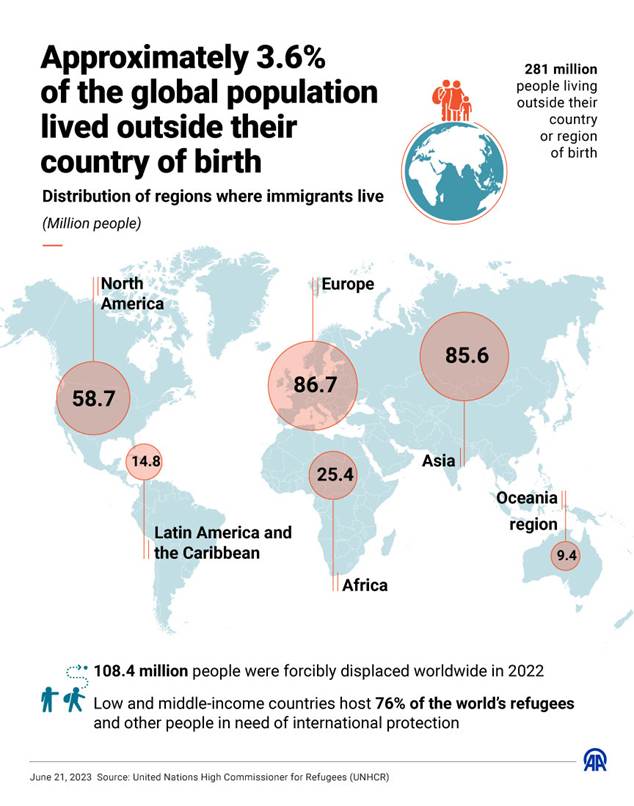
Q8 (c) “In developed countries, migration rather than fertility will be the main driver of population dynamics over the next few decades.” Examine the statement. 15 Marks (PYQ/2024)
Answer:
Introduction
Developed countries today are characterized by persistently low fertility rates accompanied by aging populations. In many Western European nations, Japan, and parts of North America, birth rates have fallen below replacement levels, leading to a shrinking or slowly growing native population. Against this backdrop, migration emerges as a critical mechanism to sustain population levels, labor market needs, and economic dynamism. In essence, while natural increase (the balance of births and deaths) declines, migration—shaped by both push and pull factors—takes center stage as the primary engine influencing population dynamics.

Demographic Trends in Developed Countries
Data from sources such as the OECD and United Nations consistently highlight that many developed nations are facing demographic challenges: low fertility rates (often below 2.1 children per woman) and increasing median ages. For example, Japan’s fertility rate hovers around 1.4, and many European countries have similar figures. Without adequate migration, these trends would accelerate population decline, reduce the size of the workforce, and strain public finances because of a growing elderly population. Consequently, governments in these regions increasingly view migration as not only an economic necessity but also a strategic tool for demographic renewal and cultural diversification.
Theoretical Perspectives on Migration
Several theories help explain why migration has become a dominant driver of population change in advanced economies:
- Neoclassical Economic Theory This theory posits that individuals migrate from low-wage to high-wage regions, seeking better economic opportunities. Essentially, wage differentials between developing and developed regions act as a pull factor. In developed countries with high living standards, economic incentives, combined with better job prospects, attract skilled and semi-skilled migrants.
- New Economics of Migration Developed by scholars such as Stark and Bloom, this framework emphasizes that migration decisions are made by households rather than individuals. It considers factors such as risk diversification and access to remittances. In the context of developed countries, households from regions with limited opportunities or economic instability may decide to migrate as a strategy to secure financial stability and invest in education or property.
- Dual Labor Market Theory Proposed by theorists like Piore, this theory contends that developed economies have segmented labor markets with a demand for low-wage, low-skill labor that native workers may not fill due to higher wage expectations. This structural demand creates a steady inflow of migrants who occupy these roles, thereby supporting economic sectors such as agriculture, manufacturing, and the service industry.
- Institutional and Network Theories These perspectives stress the role of social networks and institutional frameworks in facilitating migration. Once established, migrant communities create a support system that lowers the costs and risks of migration, encouraging further migration. Social ties, referrals, and diaspora networks help sustain and even amplify migration flows independent of broader economic disparities.
Perceptions and Policy Influences
Perception plays a crucial role in shaping migration. In developed countries, public views range from positive attitudes that see migrants as contributors to economic growth and cultural dynamism, to concerns over resource competition and cultural change. These societal perceptions influence policy decisions, from integration measures and labor market regulations to political rhetoric. For instance, nations like Canada and Australia have actively promoted multicultural policies and favorable immigration programs to counter demographic decline. Conversely, rising anti-immigrant sentiment in parts of Europe has led to tighter immigration controls, even as demographic and economic imperatives push for increased migration.
Conclusion
The interplay of low fertility rates, aging populations, and economic requirements in developed countries makes migration a crucial driver of future population dynamics. Theories such as neoclassical economics, new economics of migration, dual labor market theory, and network perspectives provide a nuanced understanding of why migration continues to flourish and eventually shape demographic trends. Moreover, public perceptions and policy responses reinforce or constrain these migration flows. Ultimately, in the coming decades, migration is poised to remain the foremost mechanism for balancing demographic deficits and sustaining economic vitality in developed nations.
Sources:
- OECD Reports (2022),
- United Nations World Population Prospects (2022),
- academic literature on migration theories (e.g., Stark & Bloom, Piore), and policy documents from countries such as Canada and Australia.
Tag:fertility rate in developed countries, Geography Case Study, Geography Optional, geography optional case study, Geography Optional Pyq, geography optional pyq 2024, human geography, migration from developing countries to developed countries, migration in developed countries, migration pattern, models theories laws and perspective in geography


